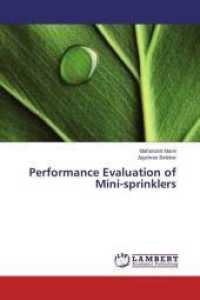Full Description
This practical, hands-on guide shows teachers how to use research-proven strategies and structured lessons to teach basic early reading skills. The authors provide an extensive array of lessons, strategies, tips, and supplementary materials to help educators strengthen students' skills in areas identified by the popular assessment system DIBELS (Dynamic Indicators of Basic Early Literacy Skills). Elementary school teachers can use DIBELS to quickly assess the critical skills underlying early reading success: Letter naming fluencyInitial sound fluencyPhoneme segmentation fluencyNonsense word fluencyOral reading fluencyThe materials are designed for students with any type of reading difficulty, including students with learning disabilities, but are equally appropriate for students of any ability level.
Contents
AcknowledgmentsAbout the Authors1. IntroductionOrganizational FrameworkUsing Assessment to Inform InstructionIncorporating Basic Early Literacy Skills (BELS) Into the Literacy BlockTeaching EffectivelyEarly Literacy Instruction in PerspectiveBuilding Early Literacy Skills2. Letter Naming FluencyActivity 1: Distinguishing Between Letters and Non-LettersActivity 2a: Distinguishing Letter Forms (Tall Letters)Activity 2b: Distinguishing Letter Forms (Short Circular Letters)Activity 2c: Distinguishing Letter Forms (Short Stick Letters)Activity 2d: Distinguishing Letter Forms (Short Hump Letters)Activity 2e: Distinguishing Letter Forms (Hanging Letters)Activity 3: Distinguishing Same and Different LettersActivity 4a: Distinguishing Uppercase and Lowercase LettersActivity 4b: Distinguishing Uppercase and Lowercase Letters (Using American Sign Language)Activity 4c: Distinguishing Uppercase and Lowercase Letters (Using Sense of Touch)Activity 5: Distinguishing Letters/Sounds (Using Sense of Touch)3. Initial Sound FluencyActivity 6a: Silly Sentence s-Part 1Activity 6b: Silly Sentences-Part 2Activity 7: Picture/Sound ChartsActivity 8a: Letter/Sound Books-Part 1Activity 8b: Letter/Sound Books-Part 2Activity 9: Sound CollagesActivity 10: Sound Identification GameActivity 11: Picture/Sound Identification Game4. Phoneme Segmentation FluencyActivity 12: "Stretching" Sounds in WordsActivity 13a: Elkonin Boxes-Identifying Sounds with FingersActivity 13b: Elkonin Boxes-Pushing SoundsActivity 13c: Elkonin Boxes-Sound BoxesActivity 13d: Elkonin Boxes-Transition BoxesActivity 13e: Elkonin Boxes-Letter Boxes5. Nonsense Word FluencyActivity 14: Distinguishing Letters/Sounds (Using Sense of Touch)Activity 15a: Sound/Letter BINGOActivity 15b: Letter/Sound BINGOActivity 16: Sound Identification GameActivity 17: Making and Breaking using Magnetic LettersActivity 18a: Blending (VC)Activity 18b: Blending (CVC)Activity 19: Sorting Beginning Consonant SoundsActivity 20: Sound LineActivity 21: Word WheelsActivity 22: Flip BooksActivity 23: Slide-a-WordActivity 24: Word ScrambleActivity 25: Word MakerActivity 26: Roll The DiceActivity 27: Match!Activity 28: Ringo!Activity 29: Go Fish6. Oral Reading FluencyActivity 30a: Reading PunctuationActivity 30b: Reading Punctuation: Period, Exclamation Point, Question MarkActivity 31: Reading Text in Phrases to Promote FluencyActivity 32: Reading Fine and Bold Printed Text as Author IntendedActivity 3: Reading fine and bold printed text as author intendedActivity 33: Reading DialogueReferences and ResourcesIndex







